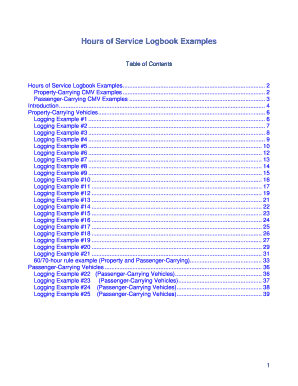Fmcsa Log Book Sample

Motor carriers must undergo a Safety Audit withinthe first 12 months of their operations to completethe New Entrant Program.A Safety Audit is a review of a motor carrier’s records designed to verify that a carrier has basic safety management controls in place to ensure compliance with applicable FederalMotor Carrier Safety Regulations (FMCSRs), Hazardous Materials Regulations (HMRs), and related record-keeping requirements. How is a Safety Audit conducted?The audit is conducted by an FMCSA-certified auditor at the carrier’s place of business, or electronically, by submitting relevant documents to FMCSA online or via mailor fax. FMCSA will tell carriers which type of audit they have been selected for by phone or mail.During the Safety Audit, carriers will be asked to submit documentation which verifies that they have established effective safety management controls. Auditors mayrequest documents related to drivers and vehicles, as well as general operating procedures and record-keeping requirements. What violations would cause a carrier to automatically fail a Safety Audit?Carriers will be notified of all violations found during a Safety Audit and provided an explanation of how to address their safety problems.
Beach king stunt racer game. Some violationsare deemed egregious enough to cause the carrier to automatically fail the Safety Audit.Automatic Failure Violations. FMCSA will provide the carrier written documentation detailing the violations that caused the carrier to fail and the requirements for developing a corrective actionplan (CAP).
The CAP must explain the actions the carrier will take to address the violations identified. CAPs must be submitted to the FCMSA Service Center within thenumber of days specified on the failure notification. Failure to either submit a CAP, or implement the corrective actions, will result in loss of FMCSA registration.Learn how to.
ThisWebsite is the exclusive property of Ol' Blue, USA.Untitled DocumentThe Hours-of-Service (HOS) regulations were. Eight logbook examples are provided below.Sleeper Berth Example #1No violation on either day.Compliance with the 11-hour and 14-hour rules is recalculated fromthe end of the first of the two periods used to obtain 10 hours offduty.Sleeper Berth Example #2No violation on Day 1.There is a 11-hour violation on Day 2 starting at 11:00 p.m. Until midnight.Compliance with the 11-hour and 14-hour rules is recalculated fromthe end of the first of the two periods used to obtain 10 hours offduty.Sleeper Berth Example #3No violation on Day 1.There is a 11-hour violation on Day 2 from 11:00 p.m. Until midnight.There is also a 14-hour violation on Day 2 starting at 1:00 a.m. Until 2:00 a.m.Compliance with the 11-hour and 14-hour rules is recalculated fromthe end of the first of the two periods used to obtain 10 hours offduty.Sleeper Berth Example #4No violation on Day 1.There is a 11-hour violation on Day 2 from 4:00 p.m. Until 9:00 p.m.There is also a 14-hour violation on Day 2 from 7:00 p.m. Until 9:00 p.m.Compliance with the 11-hour and 14-hour rules is recalculated fromthe end of the first of the two periods used to obtain 10 hours offduty.Sleeper Berth Example #5No violation on Day 1.There is a 14-hour violation on Day 2 from 5:00 p.m.

Until 9:00 p.m.Compliance with the 11-hour and 14-hour rules is recalculated fromthe end of the first of the two periods used to obtain 10 hours offduty.Sleeper Berth Example #6No violation on Day 1.There is a 11-hour violation on Day 2 starting at 11:00 a.m. Until 1:00 p.m.There is also a 14-hour violation on Day 2 from 7:00 a.m. Until 1:00 p.m.Compliance with the 11-hour and 14-hour rules is recalculated fromthe end of the first of the two periods used to obtain 10 hours offduty.Sleeper Berth Example #7No violation on Day 1.There is a 11-hour violation on Day 2 starting at 6:30 a.m. Until 1:00 p.m.There is also a 14-hour violation on Day 2 from 8:00 a.m. Until 1:00 p.m.Compliance with the 11-hour and 14-hour rules is recalculated fromthe end of the first of the two periods used to obtain 10 hours offduty.Sleeper Berth Example #8No violation on Day 1.There is a 11-hour violation on Day 2 starting at 12:30 p.m.
Fmcsa Log Book Example
Until 1:00 p.m.There is also a 14-hour violation on Day 2 from noon until 1:00 p.m.Compliance with the 11-hour and 14-hour rules is recalculated fromthe end of the first of the two periods used to obtain 10 hours offduty.